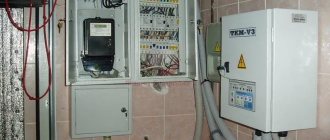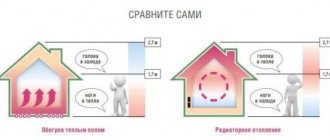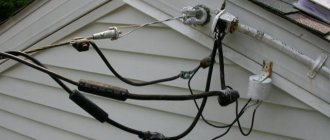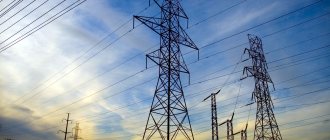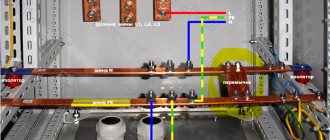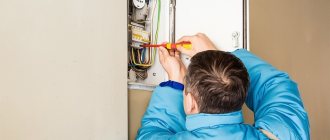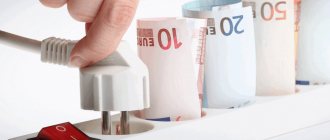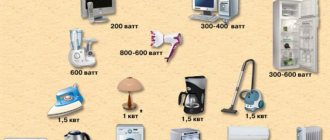Author of the article
Alexander Georgievich Kondratiev
An electrical engineer by training, he worked as an electronics engineer, chief engineer at a food company, and general director of a construction organization.
Before you begin installing an electric meter in a private home, you need to carefully study the rules. They differ significantly from the conditions for installing an electricity meter in an apartment. Typically, such metering devices are installed outdoors. This is necessary so that the energy sales inspector can easily check the status of the meter and monitor the readings.
Starting from July 1, 2022, new rules for installing metering devices will apply. Resolution of the Government of the Russian Federation dated April 18, 2020 N 554 “On introducing amendments to certain acts of the Government of the Russian Federation on improving the organization of electrical energy metering” was approved. Now electric networks install meters at their own expense, free of charge for the consumer.
According to the new law, all property will be equipped not with ordinary meters, but with “smart” ones - intelligent means of electricity metering (ISEM). For now, these are only recommendations, and from January 1, 2022, only smart devices will be allowed to be installed.
Who should install an electric meter and at whose expense
Before the law was issued, the responsibility for purchasing and installing metering devices was assigned to the owner. From July 1, 2022, there have been significant changes in legislation.
Now the purchase, installation of an electricity meter in a private house or apartment, and its commissioning are entrusted to the organization supplying electricity. In the private sector, these are electrical networks. This issue has been removed from consumers: the owner does not have to buy an electric meter, pay for installation and verification. For residents, this is conditionally free: the electric network will not present a separate bill for the device, but these costs are included in the tariff by default.
The owner must fulfill the following requirements:
- In private houses with three-phase power supply there must be a grounding loop. Parameters and permission to operate electrical equipment are issued by the electrical measuring laboratory;
- Provide access to power engineers to install the meter. At the same time, the owner must take into account that to check the functionality and take readings, free access to the electric meter is provided at any time. This involves installing an electric meter in a private house on the street. That is, it is mounted on the facade of a house, a fence or a free-standing support.
Connecting electricity meters in a private house or cottage: step-by-step instructions
Owners of apartment buildings often have to install or replace an apartment meter on the landing in the entrance. Usually this has to be done when meters, or machines, are morally and technically outdated and need to be replaced. Sometimes the city-light service directly demands that the device be replaced, removed or moved. They have no right to force the meter to be moved to the façade, but when another owner takes ownership of the old meter, significant problems usually arise. In the event of a change of user, consumers install street meters on the façade.
In each city, each electricity distribution company has its own requirements for installing an electric meter. All of them are based on the same legislative acts, but supplemented by their own orders and instructions from local services. Therefore, it is impossible to clearly indicate the procedure for registering a meter replacement, but the fact that it is necessary to start with the energy service is the same requirement everywhere.
Step-by-step instructions for performing the work:
- Turn off the machines and the phase;
- We insulate the wire;
- Using an indicator screwdriver, check that there is no voltage;
- We dismantle the old metering device;
- We attach the DIN rail;
- We install circuit breakers;
- We connect the supply and zero buses;
- Then we feed the phase;
- We mount the meter housing in place;
- Connect the wires to the meter.
After connecting the zeros, all we have to do is put the lid on our device and the work is finished.
Owner's procedure
Installing a new meter requires certain steps. They are not much different if the meter has expired or has broken down and needs to be replaced with a new one.
There is a certain procedure that the owner must follow when installing the meter.
To do this he must:
- Contact the energy sales office with an application, which will be reviewed within 7 days;
- To do this, you will need the owner’s passport or a power of attorney if the application is submitted by another person;
- The inspector will require proof of ownership. It is necessary to provide a purchase and sale agreement, deed of gift, etc.;
- Permit, technical specifications and project for installation of electrical equipment. Ground loop test report. It is provided with a three-phase connection;
- A date is agreed upon for the inspector to visit to check the correct installation of electrical equipment. The inspector must arrive no later than 15 days from the date of filing the application;
- Electrical equipment is being installed. It can be installed on its own, if the owner has the appropriate skills, or by an invited electrician;
- An act is drawn up in two copies; if installation and commissioning is carried out by a third-party organization, the number of acts will be three. It indicates the owner’s data, meter type, primary readings, seal number.
The acts are signed by all interested parties and take their copies. The owner must keep his copy. It is presented to the inspector during inspection.
Rules
The rules for installing an electric meter in a private house recommend installing it on the border of the balance sheet boundaries. This could be a wall of a house, a fence, or a separate support running along the border of the site.
The location is determined by the design organization together with the owner. It should not contradict the rules for operating electrical installations (PUE) and Government Decree No. 530. It states that the owner is obliged to provide the inspector with free access to the meter. According to the PUE and the project, the owner is obliged to comply with the conditions for installing the electrical box.
PUE 7 clause 1.5.29 prescribes the height of the electric meter. It should be within 0.8 - 1.7 meters from the ground. In exceptional cases, installation of the box at a height of 0.4 m is allowed.
In this case, the box must be designed for outdoor use. And the operating conditions of the meter must correspond to its location.
Features of connecting a single-phase and three-phase meter
Small one-story cottages are connected to a single-phase network. It is taken into account that the installed power does not exceed 8-10 kW.
In two-story houses, where the permitted power is 15 kW, three-phase meters are installed. In this case, they try to distribute the loads evenly among the phases.
The connection diagrams drawn up by the design organization are taken into account. The main difference is that with a single-phase connection, installation of additional grounding is not required. As with a three-phase connection of a private property to the electrical network.
It is necessary to install additional grounding. The layout, location and design of the grounding are indicated in the project documentation.
The differences in the connection diagram of a single-phase and three-phase electric meter are minor:
- To connect single-phase voltage, you need two wires, zero and phase, which are connected to the meter;
- For a three-phase connection, a four-wire network is used. Three phases and zero;
- It is recommended to install an automatic machine in front of the electricity meters. After it, automatic machines are installed that protect a group of consumers. For example, lighting is connected to its own circuit breaker, and the sockets are protected by another, etc.;
- If there is a ground connection, it is prohibited to connect it to the neutral wire.
In some cases, it is possible to connect a three-phase meter to a single-phase network.
Subtleties of the work carried out
When considering how to connect a single-phase electricity meter and automatic machines, it should be taken into account that the measuring equipment must be sealed. If the integrity of the seal is violated, penalties may be imposed. This is due to the fact that when opening the structure of the electric meter, it is possible to change the readings or make a connection directly, bypassing the measuring equipment.
The subtleties of the work carried out include the following points:
- To begin with, select the location where the equipment will be installed. In apartment buildings, as a rule, there is a distribution cabinet on the common staircase landing, where machines with metering meters are installed. Owners of country houses install equipment in a special box, which has high insulating qualities.
- Modular equipment is installed on a DIN rail. If there is no DIN rail, fastening is carried out through other holes in the housing. It is worth considering that the small window intended for reading readings is not designed to withstand serious mechanical stress.
- As a rule, an automatic machine is installed in front of the measuring device. It is intended for carrying out various work with the electrical network indoors, protecting consumers from prolonged overloads and short circuits. Two-pole circuit breakers are suitable for the household power supply network. In addition, other devices designed to distribute electricity and protect people and equipment from short circuits can be installed: circuit breakers, protective shutdown devices.
- When mounted on a DIN rail, all equipment is switched. For this purpose, a wire is used whose diameter corresponds to the calculated maximum load.
- The aluminum wires used are characterized by the fact that they can change their diametrical size at the connection point. This is due to the low melting point and insignificant heating of the core during the passage of electricity. That is why it is recommended that we tighten the screws from time to time. When tightening, do not apply force that could lead to thread breakage.
- After switching all connections, the correctness of the installation work is checked, after which, with the machines turned off, connections are made to the supply network. At this stage, it is not recommended to connect the load to the network.
The final stage is sealing the meter structure.
Is it necessary to install the device outdoors?
The law does not determine the location of the electricity meter. That is, there is no clear idea of where to install it - in the house or on the street. Power grids take advantage of this.
They refer to Resolution No. 350, where the owner is obliged to provide unhindered access to the meter. And it doesn’t matter to them where the electric meter will be installed, the main thing is that there is constant access.
Therefore, when issuing technical specifications, the installation location is indicated. By obliging the owner to install them on a pole or on the street, electrical networks deprive the owner of the opportunity to ensure the safety of the property for which the owner is responsible.
They don't care. When developing project documentation, electrical networks require compliance with the law, providing free access for the inspection inspector to take readings.
They do not care that the operation of electricity meters in extreme conditions leads to premature failure of the equipment. And the accuracy of the instruments varies depending on the ambient temperature.
However, if the owner guarantees unhindered access to the metering device, he has the right to install it on the premises, which is not contrary to the law.
Recommendations for selection
- Single-phase meters cannot be used for operation in a three-phase voltage network. However, three-phase versions can be connected to a household network, but their high cost makes such a choice economically unprofitable.
- The selection of equipment is always carried out according to the rated frequency and voltage. As a rule, these indicators are 220 V and 380 V, as well as 50 Hz. Other versions can be purchased for industrial use.
- The accuracy class can vary over a fairly wide range. The smaller the error, the more accurate the measurements. For models that are installed in the house, accuracy class is 2.
- Number of tariffs. If electricity is supplied at a constant tariff, then it is economically profitable to purchase single-tariff options.
- Rated and maximum current at load. Do not forget that the measuring device can only function at a certain current strength. Previously, electricity meters with a rated current of up to 5A were installed, however, today powerful household appliances have become widespread, which significantly increases the load on the network.
- If the device will be installed in a special box, then the dimensions of the structure matter.
- The interval between inspections can be 10-16 years with a service life of less than 30 years. It is recommended to select equipment that requires infrequent maintenance.
- The operating temperature range is a fairly important characteristic, especially if the meter will be installed outside the house. Too low a temperature may cause some models to malfunction.
If desired, you can install induction meters, but gradually their number in operation is significantly reduced.
You should use this service and install the appropriate meter. By using different rates, you can significantly reduce your energy costs.
What kind of meters are installed?
There are various models available for electricity metering. The most common devices were induction meters. However, these devices are outdated and are gradually being phased out.
There are electronic electricity meters with an accuracy class of 0.5. They can operate in both single-tariff and multi-tariff modes.
In the private sector, where electricity is constantly consumed throughout the day, the use of a two-tariff meter is justified. Especially if the heating is provided by electricity, and at night the area near the entrance needs to be illuminated.
And when using a washing machine with a delayed start, you can get even greater savings. Therefore, the installation of a two-tariff meter is justified.
From July 1, 2022, the installation of smart meters is recommended. They provide electricity metering and data transmission to the dispatcher automatically.
At the same time, the dispatcher remotely monitors electricity consumption in real time. In addition, smart meters allow you to monitor the status of the network and inform the dispatcher about an illegal connection or attempt to steal electricity.
In turn, through such devices the dispatcher can turn off or limit the supply of electricity and change the daily tariff. These are promising metering devices.
They are now recommended for use. And from January 1, 2022, EMIS devices should be used everywhere.
Thus, now power engineers have the right to choose the type of meter themselves. So far, the law only recommends the use of “smart” devices. Mandatory installation of automated control systems will be carried out only from January 1, 2022.
The Resolution stipulates that the purchase of equipment and installation must be carried out by the organization supplying electricity at its own expense.
If you install an “ordinary” meter now, the energy supply company is obliged to register it. Replacement will be made at the end of its service life.
In some regions, scammers take advantage of the fact that residents do not understand the laws and sell them equipment.
Induction (mechanical) electricity meters
They are a group of well-known electricity meters equipped with a rotating wheel, which is installed inside the body of the electrical appliance. The faster it rotates, the more energy consumption increases. To display information about meter readings, special reels with numbers are used.
Single-phase induction type meter
Structurally, induction meters consist of the following elements:
- Voltage coils used to limit the level of alternating current. Protects the electronic device from the negative effects of interference created by third-party sources, and also generates a magnetic flux commensurate with the voltage;
- A current coil that creates a level of alternating magnetic flux commensurate with the current;
- Counting mechanism in the form of a worm gear;
- Aluminum disk;
- A permanent magnet that creates smooth movement of the disk.
Operating principle of an induction energy meter
When connected to the network, the current and voltage coils create magnetic fluxes that pass through the surface of the aluminum disk. It is worth noting that the flux created by the current coil is different from the flux that comes from the voltage coil with its U-shape, due to which it pierces the disk several times. As a result of the influence of flows, forces of an electromechanical nature are formed that set the disk in motion.
D - disk, M - magnet, 2 - disk axis, upper coil (voltage), and lower current coil
Then the axial side of the disk interacts with a counting mechanism made using a worm (gear-screw) transmission principle, which ensures the transmission of the necessary information signals to the digital reels.
A ring with a toothed rim on top, on which a “worm” is put on, equipped with torque elements
Over time, the signal power level decreases and at this moment the permanent braking magnet begins to work, leveling out the frequency fluctuations of the disk rotation. This occurs as a result of interaction with vortex-type flows. During its operation, the magnet creates an electromechanical force that is inverse to the torsion of the disk, which helps reduce the speed of the disk or stop it completely.
Representatives of this group of electricity control and metering devices were widely used during the Soviet Union, however, even now similar devices are installed in most apartments. Such popularity and demand is determined by the simple design and low cost of the devices.
Advantages and disadvantages of induction type meters
Advantages:
- High reliability;
- Long service life (about 20 years);
- High stability of operation (no dependence on voltage drop in the network);
- Low cost.
Flaws:
- Low accuracy class (ranging from 2 to 2.5 units);
- High level of current consumption for self-sufficiency;
- Increased reading error at low load;
- Impossibility of simultaneous accounting of active and reactive types of electricity;
- Unidirectional energy metering;
- Large dimensions.
In the process of collecting information about the performance and analyzing the shortcomings of induction meters, design engineers (power engineers) developed a more advanced and reliable type of electricity metering devices, which was called electronic.

